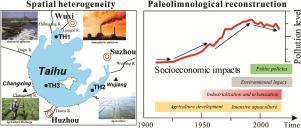Anthropocene ( IF 3.3 ) Pub Date : 2020-10-21 , DOI: 10.1016/j.ancene.2020.100269 Qi Lin , Ke Zhang , Enfeng Liu , Pierre Sabatier , Fabien Arnaud , Ji Shen

|
Human activities have greatly increased the influx of pollutants into global freshwater ecosystems. Understanding the pollution patterns at multi-decadal scales, and how the socio-economic development and public policy have shaped them, are crucial to assess the current status of environmental quality and develop sound strategies for watershed management. This study takes the test case of large Taihu Lake (∼2,338 km2) in rapidly developing regions of China, to examine the temporal-spatial patterns and driving factors of centurial trace metal and metalloid contamination. Using comparative sedimentary records, we applied multiple geochemical indices and positive matrix factorization modelling to identify the anthropogenic versus natural sources and their contributions. Results identified cadmium, antimony and lead as typical pollutants, with high anthropogenic contribution rates of 58–79 %, 54–62 % and 28–36 %, respectively. Contamination histories were asynchronous across the lake, starting from the 1940s (North) to mid-1990s (East), following the gradient of socio-economic stressors of the sub-basins. Specifically, industrial and agricultural inputs through runoff and river networks were main sources of metal in the northern and western lake parts, accounting for ≥ 70 % since the 1980s. In contrast, aquaculture and agriculture related sources (≥ 80 %) dominated in Eastern Taihu Lake over the last decade. Moreover, atmospheric metal deposition from nearby industrial cities significantly affected the northern parts of the lake. The stationary and/or slightly decreased contamination trends, especially after 2000 AD, shed light into the effectiveness of recent environmental regulation. Our findings suggest, however, that agricultural non-point sources and legacy effects probably delayed reductions in the input of pollutants. Sustainable management of similar large watersheds worldwide, therefore, would benefit by highlighting the role of multiple anthropogenic sources, legacy contamination and lake-specific response.











































 京公网安备 11010802027423号
京公网安备 11010802027423号